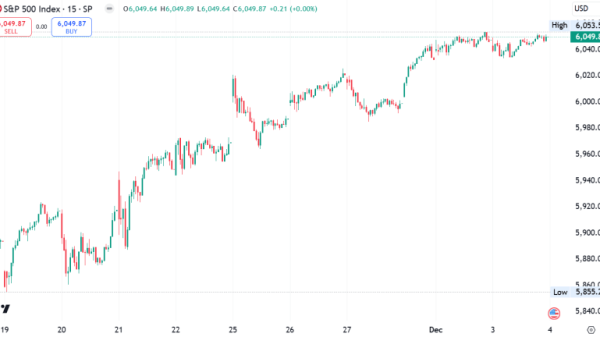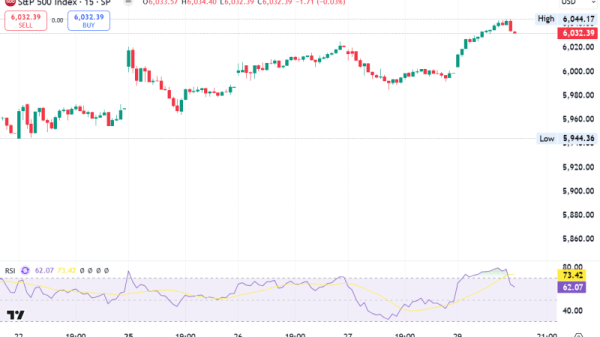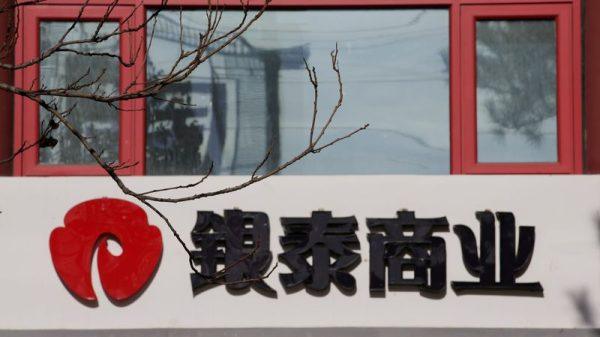Industrial and Commercial Bank of China (ICBC), the world’s largest bank by total assets, reported a marginal increase in net income for Q3 2024 during its latest earnings call.
The bank’s net income rose by 0.2% to over RMB 270 billion, with operating income reaching RMB 599.1 billion. Despite a challenging low interest rate environment, ICBC’s management remains optimistic about the bank’s growth prospects and asset quality.
Key Takeaways
ICBC’s net income increased slightly to over RMB 270 billion, with operating income at RMB 599.1 billion.
The non-performing loan (NPL) ratio improved to 1.35%, and the capital adequacy ratio was strong at 19.25%.
Total assets grew to RMB 48.3 trillion, with loans up by RMB 2 trillion.
The bank serves 755 million personal customers and 13.5 million corporate customers, with mobile banking monthly active users surpassing 200 million.
Management plans to tackle the low interest rate environment and net interest margin pressures through loan growth and asset management optimization.
ICBC expects around 10% loan growth for the full year, slightly lower than last year but above the industry average.
Non-interest income remained resilient, benefiting from robust capital market performance.
Company Outlook
ICBC anticipates maintaining positive growth despite low interest rate challenges and net interest margin pressures.
The bank aims to balance income and expenses, manage provisions, and adapt to regulatory changes.
Strategies include optimizing loan growth and asset management to stabilize the net interest margin.
Bearish Highlights
Interest rate adjustments have led to deposit rate cuts, with further reductions unlikely for the remainder of the year.
The overall net interest margin for the banking industry is low, with a forecast of continued decline into 2024.
Short-term earnings per share (EPS) may dilute post-capital injection, although long-term growth is expected.
Bullish Highlights
Loan growth is anticipated to be around 10% for the full year, with strong growth in corporate loans.
Mortgage loan growth is positive, and inclusive finance loans have increased by 26.3% year-on-year.
The bank’s FinTech investments and advancements in client engagement and service delivery are progressing well.
Misses
Net interest margin has declined by 18 basis points since the start of the year, now standing at 1.43%.
Q&A Highlights
In response to CLSA’s inquiry, Wang Hai Yu discussed the positive momentum in the bond market through September, despite fluctuations.
ICBC plans to align with government policies, optimize investment strategies, and support key sectors for sustainable growth.
In conclusion, ICBC (ticker: 1398.HK) has shown resilience in the face of a challenging financial landscape. With a focus on maintaining asset quality, optimizing loan growth, and leveraging FinTech developments, the bank is poised to continue its trajectory of stable growth.
Management’s commitment to adhering to regulatory guidelines and enhancing digital capabilities further underscores ICBC’s strategic direction in the dynamic global banking industry.
InvestingPro Insights
To complement the comprehensive overview of ICBC’s recent performance, InvestingPro data provides additional context for investors. As of the latest available data, ICBC (IDCBY (OTC:IDCBY)) boasts a substantial market capitalization of $285.85 billion, underscoring its position as a global banking powerhouse.
The bank’s financial metrics reveal a compelling valuation story. ICBC is currently trading at a P/E ratio of 4.44, which aligns with the InvestingPro Tip indicating that the bank is “Trading at a low earnings multiple.” This low valuation multiple could be attractive to value investors, especially considering the bank’s stable performance and growth prospects outlined in the earnings report.
Another noteworthy InvestingPro Tip highlights that ICBC “Pays a significant dividend to shareholders,” with a current dividend yield of 5.83%. This substantial yield, coupled with the fact that the bank “Has maintained dividend payments for 18 consecutive years,” may appeal to income-focused investors seeking stable returns in the current low interest rate environment discussed in the earnings call.
The bank’s profitability is further emphasized by the InvestingPro Tip stating that ICBC has been “Profitable over the last twelve months,” with a robust operating income margin of 64.0% for the last twelve months as of Q3 2024. This strong profitability metric supports management’s optimistic outlook despite the challenges in the banking sector.
It’s worth noting that InvestingPro offers additional insights, with 7 more tips available for ICBC, providing a more comprehensive analysis for investors looking to delve deeper into the company’s prospects.
Full transcript – Industrial Commercial Bank of China (IDCBY) Q3 2024:
Operator: Thanks for your participation. The meeting is ready to start. Please remain on the line.
Wang Liancheng: [Thank you for joining the] (ph) ‘24 Q3 investor call. I’m Wang Liancheng from Corporate Strategy and IR Department. Today, ICBC’s SEVP, Mr. Yao Mingde, the General Manager of relevant departments and subsidiaries to carry out this communication with you. The Q3 results were already released. In January, since this year, we faced with low interest rate environment. We accelerated intelligent risk control, modern layouts, digital drivers, a diversified structure, ecological foundation, the so called five transformation, we cultivated new drivers and created new balance between income and expenses. Our operations maintained robust. First, the main indicators performed well. In the first three quarters, net income was over RMB270 billion up by 0.2%. The increase turned positive. Operating income was RMB599.1 billion decreased strength NPL ratio 1.35%, down by 1 bp. Capital adequacy ratio was 19.25%. Provision coverage ratio maintained 200% above. Second, balance sheet continued to expand. Total assets was RMB48.3 trillion, up by RMB3.7 trillion. The loans increased by RMB2 trillion investments, RMB1.4 trillion. The mix continued to be optimized. Liabilities was RMB44.4 trillion, up by RMB3.5 trillion. The deposit deviation recorded the lowest in same quarter in the same term in recent five years. So, the high-quality development drivers continuing to pick up GBC Plus strategy and the ICBC continue to optimize. Personal customers increased to 755 million, corporate customers 13.50 million, MAU on mobile banking was over 200 million such as the briefing on the Q3 results of ICBC.
Wang Liancheng: Now, we will start the Q&A session. Please raise questions. And before that, please identify yourself with your institution and name. Thank you. The first question, please. The first question comes from [Xue Yan] (ph) of Morgan Stanley.
Unidentified Analyst: Thank you for the opportunity. I am the analyst from Morgan Stanley, Xue Yan. First of all, I congratulate ICBC declared Q3 net income was better than expected, but the operating income in [PPLP] (ph) were negative and the credit cost was already very low. In future, will you increase provision in Q4? Will the non-interest income continue to maintain high growth to contribute to operating income? And when NIM and fee-based income face pressure, what is the outlook for the full-year and next year’s profitability? And, will the net income maintain positive growth?
Wang Liancheng: Thank you for your support and concern for our ICBC. For this question, I would like to invite Mr. Zhang Wenwu, General Manager of Finance and Accounting Department, to answer your question.
Zhang Wenwu: First, for the provision, we follow accounting principles and regulatory requirements. The provision is decided by several relationships between several factors. First, according to the accounting principles, we consider how much provision we need to maintain. And second, how much provision we need to maintain at the end of the term. Third, how much we have spent for the provision for the term. And fourth, we consider the disposal, how much provision we have made back to the book. So, this is decided by the comparison of the multiple factors for ICBC. First, we strictly follow accounting principles and the ECL and also the regulatory requirements for provisioning. In future, all these are the premise of our future provision strategies. Second, for today’s strategy, our operation income will continue to decrease. This is a trend for the whole sector. We hope to establish a good balance between income and expense, and we need to strengthen our loan growth. First, we save the write-off resources. And second, when we assimilate the potential in some non-performing loans. By comprehensively considering the two factors, we decide how much provision we do for the term. And, when we compare the provision at the beginning and at the end of the term, we think that the provision will continue to decrease, the provision than that of the last terms. For Q4, we will continue such strategy. But, whether the provision will increase or will be back to the book, I think it is decided by the comparison of the major factors. I think by effectively managing all the resources, we will try our best to save the resources, and through disposal so as to save the new provisioning and control the credit cost to support a better performance. For your second question about other non-interest income, especially after September, our non-interest income has shown a robust momentum for Q3. Our operating income decrease was remarkably better than expected. You can see that the decrease remarkably shrinked than that of half-one. So, this comes from partially the contribution of non-interest income. There are several reasons. First, the better performance of the capital markets. So, we have seen some increase in the equity products and investments, and also when we saw the better performance of the exchange rate market. So, we have seen some better performance in the foreign exchange income and also in adapting to the new changes the financial market business have applied comprehensive tools to earn more in the trading business so that we have seen increase in non-interest income for Q4. For the performance of the capital markets, we think the attitude was quite positive. So, in equity market, we believe Q4 will continue the robust growth. And also, for debt investments, we will continue to operate well for the foreign exchange market. Now, the RMB to U.S. dollar, I think the momentum is quite robust, but it’s hard to say whether we can keep a robust growth in Q4, but we are fully confident to continue to the trend. And third, at present, net interest margin still face downward pressure. The fee-based income is affected by the fee reduction policy and some in the investment appetite of the investors, it is facing downward pressure before the full-year and next year. We have several opinions. First, from macro perspective, especially after September, we have seen multiple new policies, whether it be fiscal or financial policies. Against this background, they will provide a positive environment for the operation of the bank. The confidence for consumption is recovery. The industries are picking up, so we believe these will provide more business opportunities for banks. And, for the real estate market and LGFV, there are also policies, which is conducive to saving the credit cost for banks. We believe thus for banks, they will be conducive for the operation of the bank. Internally, we pay our attention to the pressures and challenges if we will continue our high-quality development and create a more balanced and stable balance of credit income and expense. First, adapt to the low interest rate environment and to stabilize net interest income, we think that net interest margin will still face downward pressure, but the management will continue to strengthen the adjustments of the asset mix and stabilize income and optimize loan mix and mitigate the downward pressure of interest yield and stabilized net interest margin for fee-based income and non-interest rates. Non-interest income, we will continue to let the business lines to grasp new chances, especially grasp the chances in amid the good performance of the market so as to cultivate more sources in wealth management and also the potential of subsidiaries and foreign institutions in its contribution to our income. And third, in asset quality management, we hope to strengthen asset quality management and cultivate the potential and advantage of ICBC in comprehensive risk management and also in risk cost control. We will continue such management system and promote an active prevention, smart control and comprehensive management to keep our asset quality to be stable and increase the non-performing loans disposal so as to promote the risk resilience capabilities and decrease the low credit cost by the comprehensive measures, we hope to increase we hope to maintain the balance between the income and expenses. Thank you.
Wang Liancheng: For the bond investment in non-interest income, I’ll invite the General Manager from Financial Markets Department to make some supplement.
Yao Mingde: Well, this year, the bond market performed quite well, so the trading income recorded 2.5 times compared with the last term. So, in the last three days of the term, there may be some fluctuations. But, for the full-year, the non-interest income have contributed a lot for the operating income. Thank you. The next question?
Operator: Now, let’s invite [Liying Chi from CICC] (ph). The floor is yours, Mr. Liying Chi.
Unidentified Analyst: Thank you so much for this opportunity. I’m Liying Chi from CICC. First of all, congratulations to the management. ICBC’s NIM stabilized in Q3. With the recent monetary policy package, how much impact will the interest rate cards and deposit rate cards have on ICBC’s NIM in Q4 and the 2025? Deposit interest rates have been declining in recent years. Is there any room for further decline? Considering the impact of both assets liabilities, what is the outlook for ICBC’s subsequent NIM trend? Thank you.
Wang Liancheng: Thank you so much for your question. Regarding the NIM topic, we will invite Mr. Fu.
Unidentified Speaker: Thank you so much for your question and also want to thank you for your attention to NIM. I want to answer your question in three aspects. The first one, regarding the impact of the package of monetary policy recently. The PBOC, in conjunction with relevant departments, issued a package of monetary policies to support stable economic growth, including reduced reserve ratio and interest rate cards, U.S. debt financial policies, policies to support the stable development of the capital market, to boost confidence in the market, and it will definitely promote the smooth operation of the real economy and played a very important role in favor of the commercial banks to continue sound operation. So this is speaking, first, the reserve ratio card directly provides the bank with low cost long-term funds, which is conducive to reducing the cost of bank funds and enhance the probability of our financial sector to serve the real economy. Since, these MLF and deposit interest rate decreases is conducive to reducing the bank’s cost of funds. And thirdly, the deposit mortgage interest rate decline is conducive to reducing the prepayment of loan stabilizing the size of the bank’s assets and improving the volatility of the consumption from the residence and however we also aware that with the downward adjustment of LPR deposit, mortgage rate cards and other policies, there is a greater downward pressure on the level of returns on the asset side. From the perspective of the pace of loan repricing, this round of rate card will have a very small impact on the interest income in Q4, but it will have a very greater impact on the interest income for the whole year of 2025. The volatility side is affected by the slower pace of deposit repricing and the cost saving effect of the interest rate adjustment will be relatively lagging? That’s my response to your first aspect of your question. And secondly, regarding the trend of the deposit rates, since this year, the deposit listing rate was cut twice in July and October, respectively, with a cumulative 10 bp cut in the interest rate for current deposits and a cumulative reduction of around 35 bp to 45 bp for time deposit adjusted by maturity. And, how after the reduction of the deposit listing rate in October, if there are no special circumstances, it’s less likely to be reduced again during the year. In the future, we will closely monitor the market situation, policy interest rate changes and other factors to comprehensively study and flexibly adjust the deposit leasing rate. And then thirdly, regarding the outlook on the subsequent NIM trend, currently, the overall NIM of the banking industry is at a low level, and it is expected that the trend of declining NIM and the narrowing NIM will continue next year. But the magnitude of the narrowing NIM will be narrowed. And, in the three quarters of 2024, our net NIM amounted to 1.43%, unchanged from the interim period, down by 18 bp from the beginning of this year and 7 bp narrower than the same period. While actively playing the role of a large state owned bank as the main force to serve the real economy, we have also taken initiatives to strengthen the adjustment of asset liability layouts under the low interest rate environment. On the other side, we have done a great job in arranging major asset classes, optimizing credit allocation and accurate pricing. On the liability side, we have strengthened cost control and the favorable factors for cost reduction have increased. So, the foundation of some of the operation has been further entrenched and we will maintain debt at a reasonable level. Thank you so much. That’s all for my response. Thank you.
Wang Liancheng: Now, let’s move to the third question. The third question comes from Li Chen of China Securities.
Li Chen: Thank you, management. I’m Li Chen from China Securities. The question is about loan growth. Heading into Q4 at present, will the loan growth for full-year decrease? And, how is the result for the good start of loan growth for next year? And, after the introduction of the package of policies, will the loan growth for next year improve?
Wang Liancheng: For the loan growth, I will invite [Mr. Fu] (ph) from Asset and Liability Management Department to answer. And the reserve, General Manager from Corporate Banking Department will answer.
Unidentified Speaker: Thank you very much for your question. For the full-year’s loan growth, we expect that RMB loan growth will record around 10%, a little bit lower than the same period last year, but higher than two percentage points than the average for the society and higher than five percentage points than GDP growth. There are multiple factors. First, macro perspective. At the end of September, the loan balance was over RMB250 trillion. The double-digit high growth created a good environment for economic development. But, as the economy transforms, the demand change of real estate markets and the risk control strengthened now [GFV] (ph). We believe based on such high-base, the loan growth will be lower. Our loan balance was over RMB28 trillion. I think in the future, RMB loan growth will gradually decline. The trend will be similar to that of the whole society. To maintain our support for the real economy, our loan growth will continue to be higher than the average of the whole society. Also, I hope that you can observe this issue from two sides. We adapt to the change of the social financing. Although the growth declined, but the bond investment increased by RMB2.7 trillion up by almost 15%. So, the growth in general maintained stable. Also I’d like to share that we have three characteristics in loan growth in the first three quarters. This is very important to the stable growth for the full-year. First, the RMB loans increased by RMB2.12 trillion up by 10.2%. Second, we prioritized our main business. We prioritized support for major projects. The domestic RMB corporate loans increased by RMB1.43 trillion up by 6% to 8%. Loan growth in manufacturing, emerging new industries, inclusive finance and core finance were all over 15%. And, the loans for personal consumption, personal business and credit card over draft increased by more than RMB390 billion, up by 13.3% than the beginning of the year.
Xiong Yan: For the reserve of next year, I’m Xiong Yan from Corporate Banking Department. I’d like to add that for next year, we have few points to make. I think from macroeconomics perspective, the economy will continue to recover. The long-term better performance has not changed. So, we believe the new drivers will continue to be cultivated that will pave the way for the demand of loans that comes from the national strategies along with policies are being introduced especially in recent months. We believe these can create new effective loan needs. From ICBC perspective, we see that corporate loans reserve is quite stable. In the future, we will follow the leaders of the new policies and increase our loan growth and especially the NDRCs, multiple projects such as in nuclear power projects will continue to refine management and help at the end of next year or Q4 the growth of the loans for ICBC? Thank you.
Wang Liancheng: The fourth question, and let’s invite [Shilin Yin] (ph) from Bank of America Securities.
Unidentified Analyst: Thank you so much for this great opportunity. I’m the analyst from Bank of America Securities, Shilin. And, what is overall trend of your bank’s asset quality? What is the change in asset quality of real estate related loans? And, has there been any optimization of credit policy for housing related loans where the recent interaction of real estate policies led to the masking and underestimation of real estate credit risk?
Wang Liancheng: Thank you so much for your question. And, now we will invite [Mr. Li De] (ph) from the Credit Management Department. Thank you so much, analyst, for your question. And, for the first three quarters, the bank’s credit asset quality was stable and improving with NPL ratio of 1.35% at the end of September, down by one bp from the beginning of this year and unchanged from the middle of this year. The average NPL ratio of corporate loans in deposit branches was 1.42%. So, for the next step, we will continue prudent operational principles. In particular, we need to be aware of the whole package of policies issued by the central government, which will facilitate our economic growth and the stimulation of the real estate market. I believe that with a better market environment for commercial banks, especially for ICBC and other big banks, we have a very favorable environment. As for the real estate market, actually, in recent years, this sector for our commercial banks has been the center of the attention, and we have taken a very active attitude to deal with the new changes in the real estate sector. For the first nine months, we have strengthened the disposal of the bad asset. And also, we have a very adequate detail on provision. That’s why by the end of September, the NPL ratio is about 5.26% and down by 11 bp. Besides, we have followed closely the new policies regarding the estate market, and we have witnessed the recovery of the market for the first three weeks of November for the [Shanghai and Shenzhen] (ph). And, we found that the transaction and deals has reached a historical high over the past 18 months. The confidence and expectations of the consumers have enhanced and also the situation for the real estate developers have also relaxed. We believe that when commercial banks take the initial active and to manage and real estate risk will create a more favorable environment, you may know we have maintained a prudent operation principle. For instance, we will have the trinity principle of the cities and projects and also the houses and also maintained the reasonable ratio of the real estate of the total loans. So recently, we’ll continue to reasonably manage our real estate asset layout and actively promote the disposal of the NPL related to the real estate sector. Besides, you may have noticed that the regulator has issued some very favorable policies, for instance, and default cancellation for decline and therefore additional approaches, and we will promote the sound development of the real estate market by following relevant regulations. Thank you.
Wang Liancheng: The fifth question, please.
Operator: Next question comes from Chen Junliang of Guosen Securities.
Chen Junliang: My question is, after the introduction of the new policy, how was your mortgage loan growth? Is there a positive growth? And, will the repricing of the outstanding mortgage mitigate early repayments and what about the asset quality and the future trend? We see increasing trend of consumption loans, operating loans and credit card NPL ratio, what measures will you put in place to control such risks?
Wang Liancheng: Thank you very much. I’ll invite Mr. Song Jianhua, the General Manager of Personal Banking Department, to answer your question.
Song Jianhua: Thank you very much for your concern for the Personal Banking business. For the multiple new policies, they are related to releasing purchase limit, down payment proportion decrease and also the decrease of interest rate. This can help the recovery of the real estate market from the short-term results, we have seen that the willingness of people buying houses has been recovered in some new houses, secondhand houses. We have seen more deals for the first month after the introduction of the new policies, our personal mortgage application and loan growth have seen increase compared with last quarter. But, as the policy was only introduced for a short time, the results appear to be observed for a longer term. In the future, as the policies continue to be implemented, as the economy continues to recover and real estate market continues to pick up, we are confident about the positive growth of mortgage loans. In adjusting the outstanding mortgage interest rates, we have completed the adjustment of the interest rates of the outstanding mortgage that is LPR deducts 30 bps. For most outstanding loans, this can lower down the burden of the interest rates payments of people and it can also reduce the willingness for early repayment. Recently, we have seen that the amount of early repayment has decreased. We expect that as the interest rate of the outstanding mortgage compares to that of the new loans and the economics continue to improve, we believe the early repayments will be back to a reasonable level. In asset quality, since this year, ICBC’s personal mortgage NPL ratio has seen some slight increase. This is in-line and this is the same for the sectoral trend, but the absolute number is still very low and the general asset quality is quite good. The transmission of credit risk will require a process. In short-term, the NPL ratio may increase slightly, but some mid-term and long-term as economic development continues to be stable and people’s income continue to improve, the asset quality will be stable and will be good. And for other retail loans, their asset quality shows the same trends and that’s of the whole sector. We have seen growing trend in NPL ratio since this year, but it is still in reasonable range. As a package of new policies continue to be implemented and the positive factors for economic growth continue to pick up, we believe that the asset quality for personal loans will continue to be manageable. Second, in the future, from three aspects, we will coordinate the development of personal loans and the management of the risks. First, we will continue to strengthen and increase the personal loans. We think at present, there are still potentials for personal loan growth. When we implement the new policies, promote people’s consumption. We believe this can be conducive to establishing a good environment for management of risks in personal loans. Second, we will accelerate digital drivers transformation. This year, we have introduced five transformations. In personal loans field, we will try to increase digital drivers. Our focus is to increase digital risk management capabilities, improve standardized line of credit and risk management. We will center on ECL management, optimize on-boarding model and blind credit model and post loan management model. Third, we will improve and intensify the intelligence and digitalized post law management to horizontal and vertical management. We will increase the pre-earning warning system for personal loan risks and to improve the risk management effectiveness. Thank you.
Wang Liancheng: Next question please.
Operator: Let’s invite Liang Fengjie from Zhejiang Securities.
Liang Fengjie: Thank you so much for this great opportunity. I have a question, which is about inclusive finance. What were the investment structure and the pricing of inclusive loans in the first three quarters of this year? Just since the NFRA indicated that it will further optimize our policy of non-reparable loan renewal, including expanding renewal targets and adjusting the risk classification standard. What is the implementation status of non-reparable, loan renewal and the corresponding risk of ICBC? What is the outlook for the asset quality of inclusive loans in the future?
Wang Liancheng: Now let’s invite [Tian Fenglin] (ph) from the Inclusive Finance Department.
Tian Fenglin: Thank you so much for your question. Focusing on the high-quality development of inclusive finance, ICBC has integrated the requirements of the national strategy. And by the end of Q3, the balance of the bank’s inclusive loans amounted to about RMB2.81 trillion with an incremental of RMB585.9 billion, an increase of 26.3% and the share of inclusive loans in the balance and incremental of all loans was further increased. The number of inclusive finance customers exceeded 2 million, an increase of nearly 40% during the year. So, based on the fast growth, we mainly targeted at the science and technology innovative business and manufacturing industries and the micro and small-sized enterprises and to help them with expanding domestic need and industrial upgrading. For instance, we upgraded the new generation operation expressed loans to further enrich the supply of the credit related products and expand the coverage of our customer base. And, we have also explored the scenarios of industrial chain and explored the financing solutions, that is related to digital supply chain, and we also encourage innovative products tailored to the different areas. By the end of Q3, our individual loans from the small-sized and medium-sized enterprises, the growth rate is much higher than other kinds of loans. And so, in this context of the overall interest rate adjustment, we have maintained the online department, intensive and intelligent department, focusing on solving the problems of information asymmetry and promoting the enhancement of risk prevention and control as well as efficiency operation and management. We hope that by further lower cost and enhanced efficiency, we can increase the feasibility of inclusive finance for the first three quarters. And, the average interest rate of interest loans is about 3.37%, which is very reasonable. In terms of non-relevant , we do believe that to meet the operational needs, especially the financial needs and stimulate their dynamics and support the real economy is very critical. And also, for the banking and other relevant financial institutions to provide high-quality services will enhance the customer [consistency] (ph) risk and optimize the structure and effectively prevent risks and also to create long-term benefits. So recently, based on the policies of the CBRC, we have continuously provided very high-quality development. And, on September 24, the financial regulator, the NFAR, issued the secular, which is based on the previous policy and made some improvement, and we implemented the policy. And, we will stick to risk orientation and to provide the credit and the services to the businesses that have good reputation and have no bad record. Besides, we will also based on implementing the policies and combining the procedures of loan renewal and continuously monitor risks and management of loans and stress the review and distribution of the whereabouts of the loans and analyze the risks and also enhance our early warning capabilities and to enhance high-quality development. In terms of asset quality, HSBC has speak to online and offline integrated development and digital governance and expertise and enhance the full process, risk control mechanism for inclusive finance, and we also stress the joint prevention and control from the front, middle and back office. And also, by the end of September, our NPL ratio has maintained at a reasonable level. And mainly, in the business access, we have integrated multi-dimensional data from both inside and outside of bank iterate and optimize the functions of business access, monitored and had used in our early warning models as well as identify risks in a forward-looking manner in a no duration stage, we’ll continue to do a good job of risk marking and enhance the efficiency of risk prevention. And also, in the deposition and the treatment, we have expanded the channel so as to enhance the efficiency and broaden the channel of disposal. Recently, the whole package of our financial policy has conveyed very big great signal to the market, and we believe that it will set a very great foundation for stabilized asset quality. And based on that, we will continue to promote high-quality development of inclusive finance and continuously enhance the intelligent management level of risk prevention and control and consolidates the sustainable foundation of inclusive finance so that it will be more practical and more long-term and of high-quality. Thank you again for your question.
Wang Liancheng: Thank you so much, Mr. Tian. The second question, please.
Operator: The next question comes from XiaoFei of CITIC Securities. Q – XiaoFei Ma Thank you very much. My question is attracting attention recently. Recently, share buyback and holding increased loan facilities have been gradually implemented. We’ve already seen several companies disclose loan credit lines granted by ICBC. Could you provide an update on the number of companies who have reached a cooperation agreement so far and the estimated loan amounts? What types and attributes of clients are the primary focus? Are there specific qualifications or scale requirements for companies seeking repurchase and holding increased loan facilities?
Wang Liancheng: I’ll advise [Ms. Zhan Zhang] (ph) from Investment Banking Department to answer your question.
Unidentified Speaker: The listed companies have been a focus of our financial service. Our comprehensive service has been quite fully covered. PBOC, National Regulatory Administration, have set the related notice. We have followed the requirements. We have followed the principle prioritizing internal controls and establishing systems. ICBC launched a new specialized credit product, becoming the first to establish a comprehensive framework of products, systems and processes for repurchase and increased loan facilities. You asked about client selection. In 2023, we followed National Financial Regulatory Administration requirements. ICBC treated these companies across different ownership structures equally. We have approved several business. They can apply for their loans according to their need. You have seen some release, and we have already granted loans for the first batch of clients and several customers have signed agreements with ICBC. And, the list of companies are promoting the information disclosure according to requirements. For the business types, the loans that’s related to share buybacks or holding increase, we cover main [choice, new choice mix] (ph), and we support the transformation and upgrading of traditional industries and also support the development of emerging industries. In the future, we will continue to implement the loans and we will leverage our advantage in financial services when we strengthen the confidence of the market sentiment and also we will strengthen our financial services for the shareholders and continue to play the role for serving the real economy. Thank you.
Wang Liancheng: The eighth question, please.
Operator: Let’s invite Bennett Chu from UBS Securities.
Bennett Chu: Thank you so much for this great opportunity. I also have a question, which is currently related to everyone’s attention. Recently, the state announced a capital injection to largest state owned banks. What is the outlook for the scale, pace and the pricing of capital replenishment? Will there be a further increase in credit expansion after the completion of capital replenishment? Will the capital injection have a much more impact on subsequent capital replenishment, including TLAC insurance? Will the dilution of EPS and dividend after the capital increase be absorbed by earnings growth in the medium until the long-term? Thank you so much.
Wang Liancheng: And this is related to our credit management, so we will invite [Fu Jie] (ph) to address your question.
Unidentified Speaker: First of all, thank you so much for your question. Let me first introduce the overall situation of ICBC’s capital management. In the first three quarters, we actively promoted the capital management measures for commercial banks in accordance with general ideas of endogenous and balanced development, optimized capital management, enhanced efficiency of capital use. At the end of Q3, our ICBC’s capital adequacy ratio stood at 19.25%, with core Tier 1 and Tier 1 capital adequacy ratio at 13.95% and 15.23%, respectively, which continue to meet a relatively good level compared with our counterparts. This is an overall picture. Regarding the scale, pace and pricing of capital management, recently, regulator indicated that it will increase the core Tier 1 capital of six large commercial banks and implement it in an orderly manner in accordance with the idea of advancing in an integrated manner, phasing by batches and individualized plan for each bank. And now, the specifics are not clear yet, and we are still working on the relevant proposals and also had talked with the regulators. I believe that when there are more identified and finalized content, we will timely communicate with the investors. And then secondly, regarding the credit expansion after the completion of capital management, we believe that capital injection is definitely conducive to strengthening the bank’s capital strength and enhancing our credit investment capability and ability to serve the real economy. So for the next step, we will take full consideration of the policy orientation, economic growth rate, market supply and demand and business strategies to coordinate the credit expansion efforts, prioritize to meet the financing needs of major strategies, key areas and the weak links and further enhance the financial service capabilities. And, regarding the impact of the capital injection and subsequent capital replenishment, including the marginal impact of the lack insurance, we believe that definitely, it will have some marginal impact on TLAC. However, as the amount and timing of the capital injection have not yet been determined, it’s very hard to tell the extent of the impact. However, we will after the plan is determined, we will reasonably arrange the pace of the insurance of capital instruments and the TLAC bond in accordance with the actual capital injection and the operation situation of the capital indicators in the future. The bank will successfully achieve the first phase of TLAC target by the end of this year, and they will steadily push forward the second phase of initiatives and the subsequent TLAC bond insurance under the guidance of regulators and shareholders to ensure that regulatory requirements are met on schedule. Regarding EPS and dividend admission after the capital injection, we believe that it will have the phased dilution of EPS in the short-term. However, for the medium and the long-term, it will be conducive to the sound development of large banks, including ICBC and the creation of a sustainable value for shareholders. We hope that with our efforts in all aspects with a short-term period of time, we can absorb such impact with our better performance.
Wang Liancheng: Thank you so much, [Mr. Fu] (ph). The ninth question please.
Operator: The ninth question comes from Cheng Chen of Haitong Securities.
Cheng Chen: Thank you for the opportunity to raise questions. My question concerns FinTech. My question is what are the progress and key achievements in the ICBC development during the first three quarters of this year? Will technology investments start impacting profitability? And, will this be reflected in cost, interest margin or lower credit costs? How do I see this as your cybersecurity management and development?
Wang Liancheng: Thank you very much for FinTech. I’ll invite the General Manager of FinTech Department, Mr. [Yanlong Ru] (ph), to answer your question.
Unidentified Speaker: Thank you very much for your concern for FinTech. For the ICBC establishment, there has been several years since the introduction of the ICBC. We have been improving steadily. First, the clients reach availability, competitiveness and the stickiness of clients, we try to improve all these aspects. And for externally, we show it in our three platforms, for example, mobile banking, ICDC e-Life and the open banking platform, we are trying to improving and polishing our systems. For example, in mobile banking, we are doing version 10. In the future, we will introduce the new version and also you may observe the development of HarmonyOS version. We will also introduce such a version in the future. And also, we are improving the ecological rights protection for the industry Internet and the specific industry’s need, we are improving our plans. Internally, we center around the need of our employees. We have two groups: one is client managers and second is the outreach working employees on the counters. We improve our effectiveness and service of the financial products. And second, we are improving the office environment. For example, in outlet services, we synergize online and offline services. Our clients, our employees exceeded the number of tens of millions. So, the results have been quite fruitful. And, the second result is that the improvement of products and services, which can adapt to all kinds of demand and clients. For example, in corporate banking, we focus on the corporate e-banking. Especially this year, we have made improvement in several aspects. Also, the Inclusive Finance department also mentioned the intensification and the intelligence of Inclusive Finance. The ICBC development also helps the improvement of inclusive finance. Also, we have a traditional advantage, for example, the custody settlement. We enlarge our investments and expand the ICBC worldwide payment system and the cross border clearing system. And thirdly, for the risk management, we play giving to full play the advantage in risk management of ICBC. And, we have corporate level and group level smart risk management system. This year, we will see milestone. So gradually, we will fully implement our risk management system. And also, when we adapt to the technology change, we transform from traditional model to the new model of more open so as to improve the flexibility of the system. In new technology system, especially that with AI, we have seen fruitful results and improvements in industrial level and RMB100 billion level scenarios we have supported a lot and improved our products and services. These are several aspects I can give you. As examples, we also put people at the center of our work. We explore the integration of people and technology. For example, we have IDBP plan, in which how technology employees can be better incorporated into business need so as to integrate and given to full play the effectiveness of data, this is cooperation between our department and the HR department so as to make the digital change incorporated in all kinds of branches center around clients reaching and ecosystem support and the operation for the clients. We are improving such supporting system. This is my brief introduction for the ICBC. For technology for FinTech Investments, this has aroused great attention from the market. Last year, ICBC’s Fintech investment totaled RMB27.2 billion, including all kinds of fees, HR, the cost of salaries. But for the direction, we think the level is quite reasonable. I think the proportion of the Fintech investment accounts for 3% of the total operating income. In the large banks, this is quite an amount. The investment is used in the upgrading of equipment second to the development of financial services. The five major tasks requires the upgrading of models and products. So, this year, based on last year’s investments, our daily average transaction almost reached RMB1 billion, increasing by 10% compared with last year. These all require the upgrading of equipment. And third, some new technologies and strategic layout, in particular, AI development. You know that the cost of labor is still high, but all levels of the employees believe that AI will be conducive to the upgrading of the banking system and the driver for the development in the future. So, we have made some proactive arrangements in this regard. You also mentioned the results we can see. I think the results can always be seen. I see business assets, for example, in recent years, increased by several trillion, but the number of employees actually decreased. From my understanding, the development of Fintech is a core driver. This can show the value of ICBC. For some direct contribution, for example, last year, the digital employees, robots, the automatic process, we can calculate the workload was over 30,000 employees. We are doing some quantitative transaction, which cannot be done by humans but can be done by the technologies. These are the value contribution of the development of the ICBC. In the arrangement and system of the investments in Fintech, we have a full process from the investments and the post evaluation, we have mechanism to assess to guarantee the effectiveness and results. For cyber security, in general, the challenge is a little bit high for cyber security. We see the attack maybe industrialized. There are also factors like geopolitical contradictions. But from the perspective of technologies, we think IT development is quite important. First, the business operation security, we need to keep the 1 billion transactions that can be operated stably. We can serve over hundreds of millions of customers personally and tens of millions of corporate customers for the several past years. In general, in the continuity of business operation and the support of the security, we have made some achievements. And second, for cyber security, we are facing several million of potential attacks. For the full year, the number may be 400 million. The increase was over 20 times over the past. So, the pressure is quite high, of which the most pressure comes from the global operation of ICBC. We’re 100% confident about domestic operation in China, but there’s also such protection should also be expanded to other institutions in other countries. We are doing this job to put the system of early warning system and the security system to be expanded globally. And third data security, how can we implement the national level data security laws and regulations to increase our data security in its effectiveness. We are actively promoting such work. The classification, we have completed the required work. We will continue to strengthen our job. From present situation, we are confident about ICBC’s business security system to improve it to a higher level.
Wang Liancheng: Thank you. Okay. So, we will proceed to the 10th question.
Operator: We will invite [Chen Hu] (ph) from CLSA.
Unidentified Analyst: Thank you so much for this opportunity for raising the last question. I’m [Chen Hu] (ph) from CLSA. How about the bond investment situation and the revenue contribution in the 1st 3 quarters of this year? At the end of September, the equity market rose strongly and the seesaw between stocks and the bond has increased. How do you look forward to the performance of the bond business in the Q4 and next year? Thank you so much for your patience and for your attention.
Wang Liancheng: Now we will invite [Wang Hai Yu] (ph) to address your question. Thank you so much.
Unidentified Speaker: Indeed, just as you mentioned that overall, the bond market from the beginning of this year to September and the momentum is quite good. Therefore, the Q3, there are some changes because for the last week, there are some rebounds because of some major events. For instance, in early August, the Central Bank of Japan increased interest rate that led to market fluctuation. And also in the mid-September, the Fed decreased the interest rate by 50 bp. And also in September, the package of the financial policies was rolled out by China. So, we have timely adjusted our policies for the first three quarters, and we have increased the income from the bond market by about RMB10 billion and also the total incremental value of the investment is over RMB20 billion. So, looking forward to Q4 and the next year, in the bond business, at now the name is narrowed, while the monitoring and the fiscal policy stabilized and gradually implemented as well as the impact of the election of the U.S. to the overseas market, we think that the fluctuation in the bond market will increase. However, we believe that the liquidity is pretty well and also the short-term interest rate is decreasing. The shortage of good asset is fundamental of the bond market. So, we think that the overall risk of the bond business is still under control even if the fluctuation will be strengthened. For the next step, we will continue to implement the policies of the central government and strengthen our forward looking measures and judgment and to adjust our policies according to the changes of market and maintain the control and the pace of our measures and also to optimize our investment strategies and to balance the income from the NIM and also from the prices and to make our bond businesses more sustainable and sound. And also, with the current the package of our financial policies, we will play our role as a leader in this area and to assess the real economy and strengthen our investment in green development, innovative development and also the investment in the key sectors and the weak sectors. And in terms of transaction, we will fulfill our role as the market maker and to enhance the flow and also the transaction and to facilitate high quality development of interbank businesses and also to increase the contribution of bank businesses to our overall revenues. Thank you.
Wang Liancheng: In the interest of time, the Q3 performance briefing is to an end. Thank you so much for your question and also want to thank our Governor, [Yam] (ph). If you have any questions, feel free to contact our IR team and that will be the end of our meeting and wish you all happy and healthy and all the best. Thank you so much.
This article was generated with the support of AI and reviewed by an editor. For more information see our T&C.




































